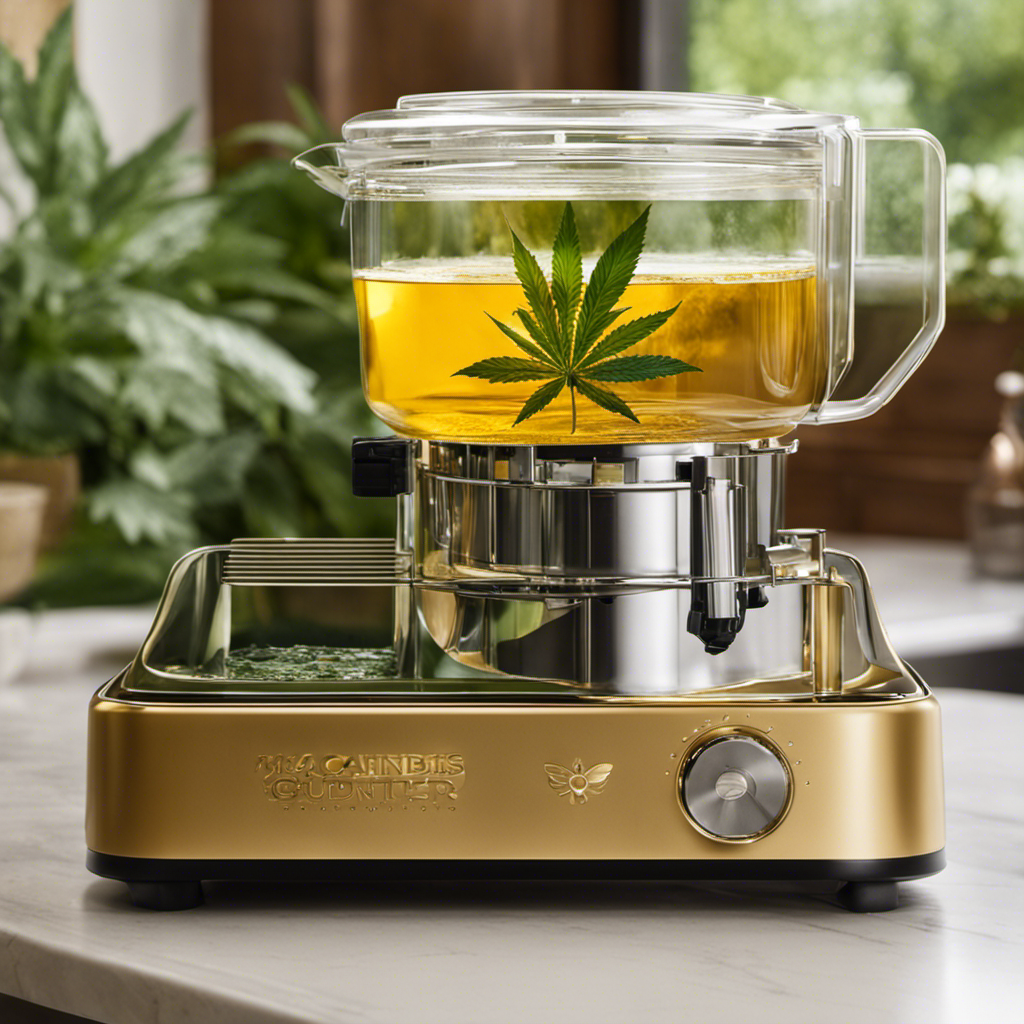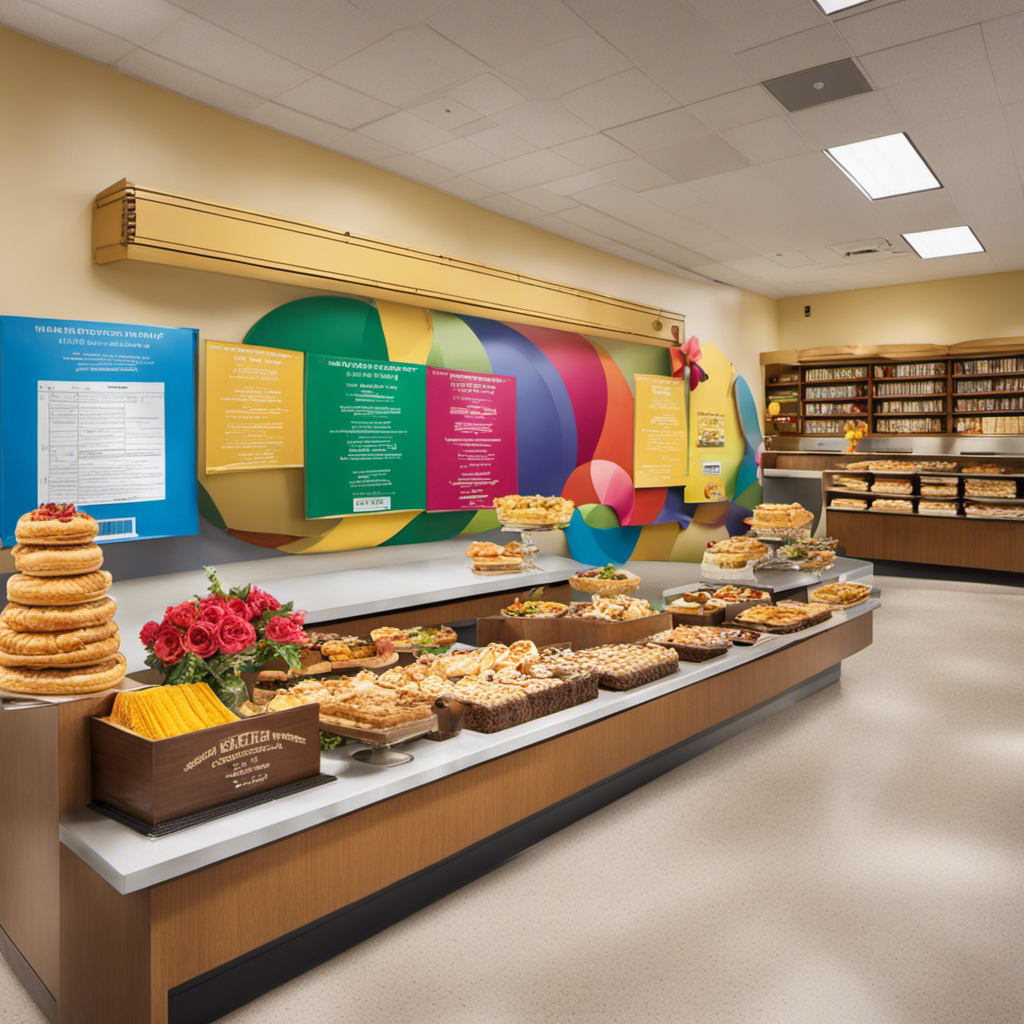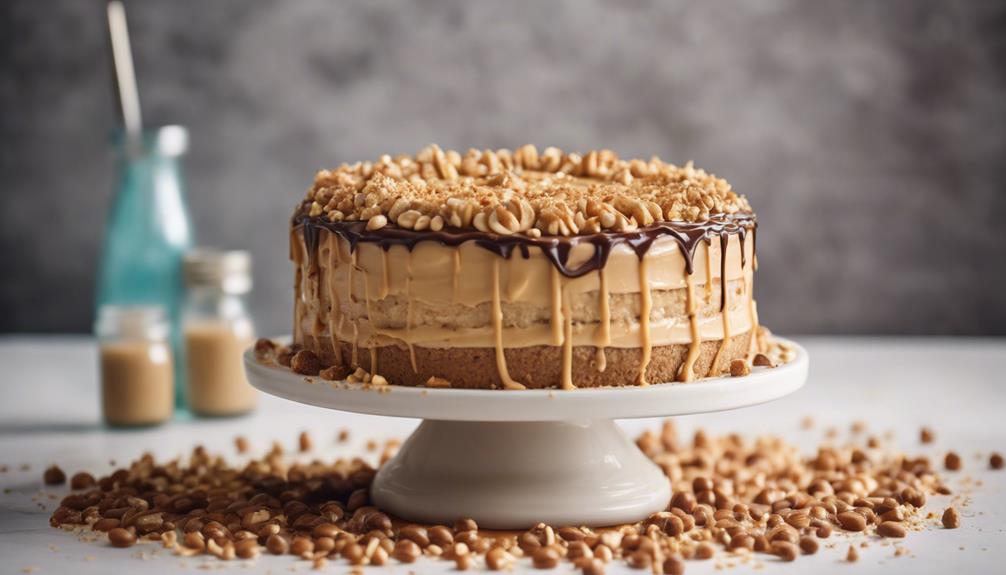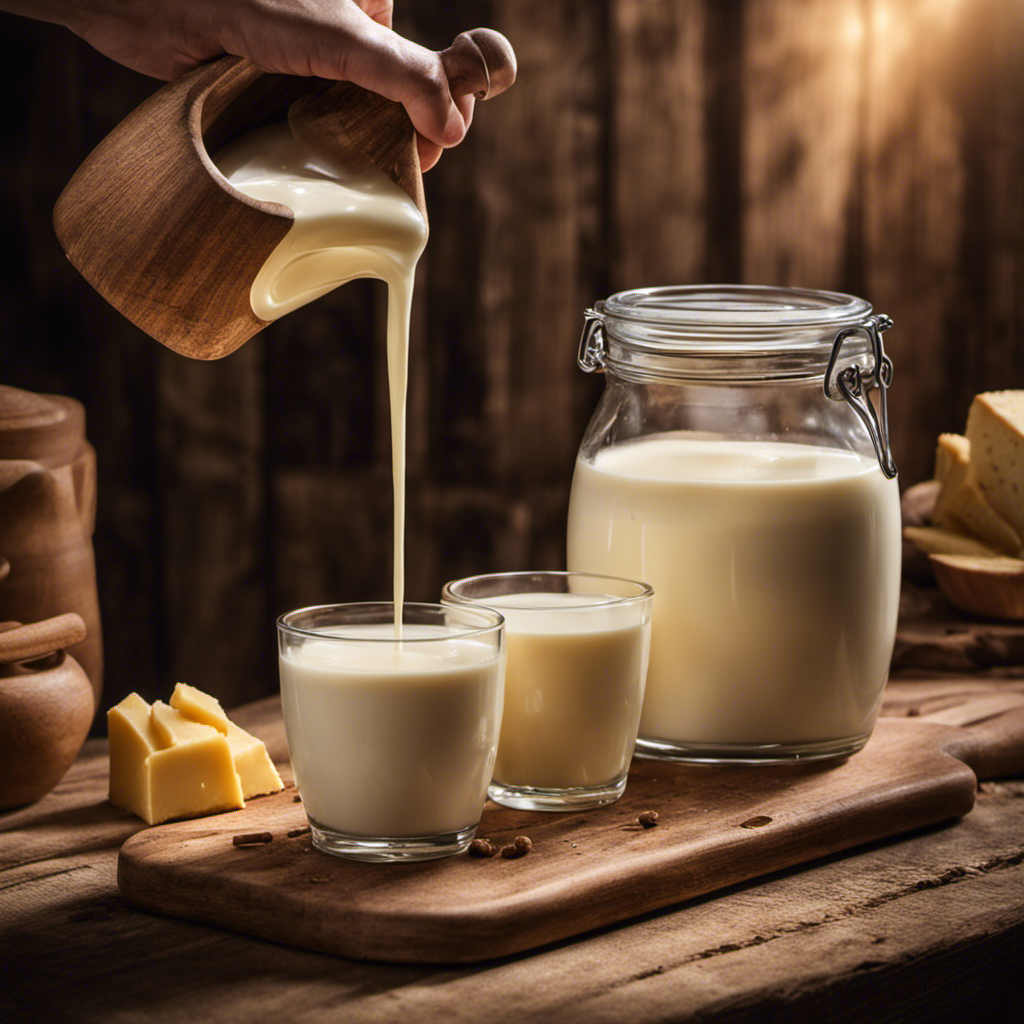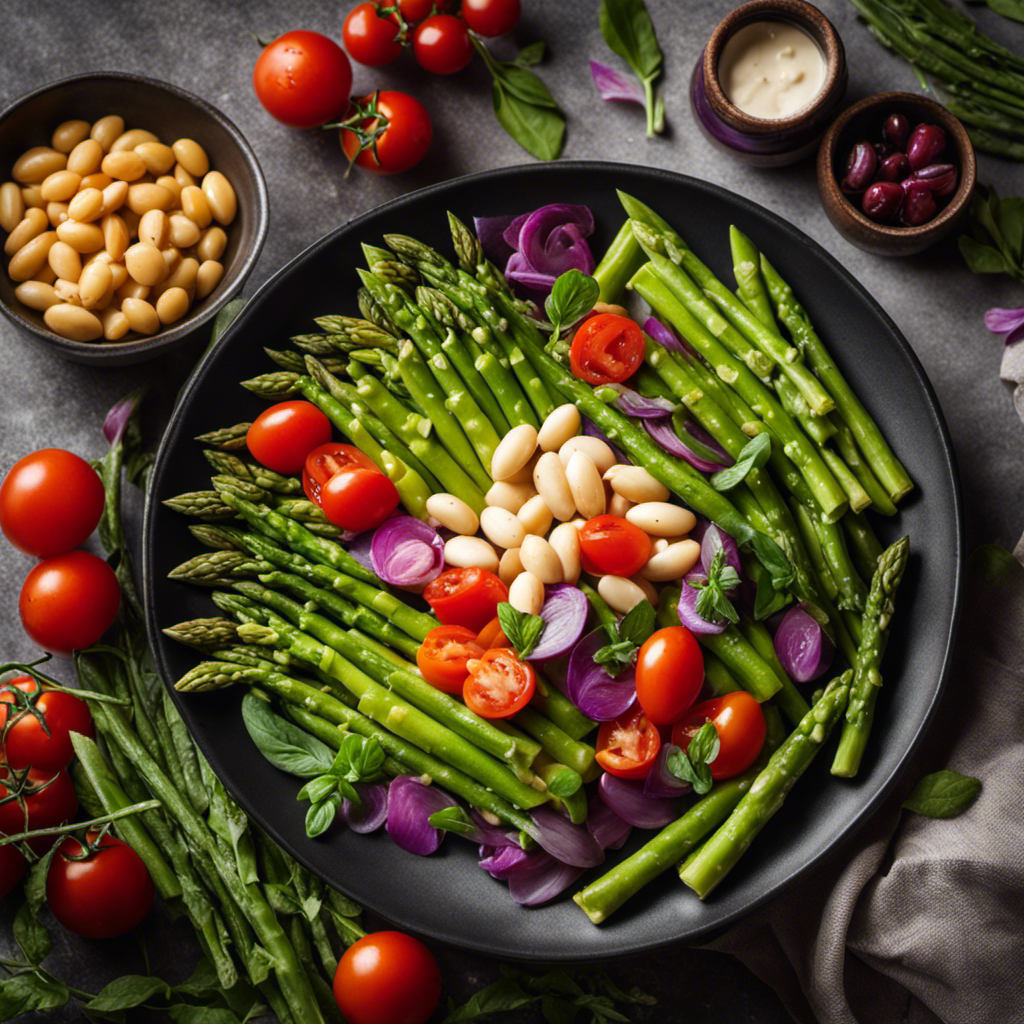I’m here to reveal the secret to making Papa John’s famous garlic butter sauce.
Get ready to elevate your taste buds with this perfect blend of rich butter and fragrant garlic.
In this article, I’ll walk you through the step-by-step process, from choosing the right butter to infusing it with mouthwatering garlic flavors.
We’ll also explore tips and tricks for enhancing the taste and preserving your homemade garlic butter.
So, grab your apron and let’s dive into this delicious adventure together.
Key Takeaways
- The ingredients for Papa John’s garlic butter include freshly minced garlic cloves, unsalted butter, and optional additional ingredients like parsley, lemon juice, or Parmesan cheese.
- Alternatives to garlic butter include herb-infused olive oil or a blend of roasted garlic and mayonnaise.
- The recipe calls for 1 cup (2 sticks) of unsalted butter, 4 minced garlic cloves, and 1/4 teaspoon of salt.
- The garlic butter should be stored in an airtight container in the refrigerator to maintain freshness and longer shelf life.
The Secret Ingredients You’ll Need
To make Papa John’s garlic butter, you’ll need a few secret ingredients. The base of this deliciously rich and flavorful butter is, of course, garlic. Freshly minced garlic cloves are the key to achieving that authentic taste.
Alongside the garlic, you’ll need unsalted butter, which provides the creamy texture and richness that complements the garlic perfectly. Other variations of garlic butter may include additional ingredients like parsley, lemon juice, or even Parmesan cheese for added depth of flavor.
If you’re looking for alternatives to garlic butter, you can try using herb-infused olive oil or even a blend of roasted garlic and mayonnaise.
Now that we know the secret ingredients, let’s dive into the step-by-step instructions for creating the perfect garlic butter.
Step-by-Step Instructions for Perfect Garlic Butter
When it comes to making the perfect garlic butter, there are a few key points to keep in mind.
First, the ingredients and measurements must be precise in order to achieve the desired flavor and consistency.
Second, cooking time and temperature play a crucial role in ensuring that the garlic butter is cooked to perfection.
Lastly, knowing how to properly store the garlic butter and understanding its shelf life is essential for maintaining its freshness and taste.
Ingredients and Measurements
The first step in making Papa John’s garlic butter is gathering all of the necessary ingredients and measuring them out. Fresh ingredients are key to achieving the best flavor, so make sure to use high-quality butter, garlic cloves, and salt. Here’s what you’ll need:
- 1 cup (2 sticks) unsalted butter, softened
- 4 garlic cloves, minced
- 1/4 teaspoon salt
Using fresh garlic cloves will give your garlic butter a robust and authentic taste. The butter should be softened at room temperature to ensure easy mixing.
Once you have all the ingredients ready, it’s time to move on to the next step. But don’t limit yourself to just using garlic butter on pizza! It’s a versatile condiment that can be used as a spread on bread, melted over vegetables, or even added to pasta dishes for a burst of flavor. Get creative and explore the various ways to enjoy this delicious garlic butter.
Cooking Time and Temperature
Once you’ve gathered and measured all the ingredients, it’s important to cook the garlic butter at the right temperature and for the right amount of time to achieve the desired flavor and consistency. Cooking techniques play a crucial role in ensuring that the garlic butter turns out perfect.
To begin, melt the butter in a saucepan over medium heat. Add the minced garlic and cook for about 30 seconds, stirring constantly to prevent burning. This will help release the aromatic flavors of the garlic. Be careful not to overcook the garlic, as it can become bitter. Adjust the heat as needed to maintain a gentle simmer.
After the garlic has softened and the flavors have melded together, remove the saucepan from the heat and let the garlic butter cool slightly. This cooking process allows the garlic to infuse into the butter, creating a rich and flavorful sauce.
Storage and Shelf Life
Storing the garlic butter in an airtight container in the refrigerator will help prolong its shelf life. When it comes to preserving homemade garlic butter, it’s important to take proper precautions to ensure its freshness for as long as possible. Here are some tips to extend the shelf life of your garlic butter:
-
Keep it refrigerated: Cold temperatures slow down the growth of bacteria and help preserve the butter.
-
Use an airtight container: This will prevent air and moisture from getting in, which can cause the butter to spoil faster.
-
Keep it away from strong odors: Garlic butter is prone to absorbing odors from other foods, so keep it away from strong-smelling ingredients in the fridge.
Choosing the Right Butter for the Recipe
When it comes to choosing the right butter for a recipe, two important factors to consider are whether to use salted or unsalted butter, and whether a clarified butter substitute can be used.
Salted butter adds a savory element to dishes, but can alter the overall saltiness of the recipe. On the other hand, unsalted butter allows for more control over the seasoning.
Additionally, clarified butter can be a suitable substitute in certain recipes, as it has a higher smoke point and a longer shelf life.
Salted Vs Unsalted Butter
To make Papa John’s garlic butter, you’ll want to choose between using salted or unsalted butter. The choice between the two depends on personal preference and the desired flavor profile of the garlic butter. Here are some key points to consider:
-
Salted Butter Benefits:
-
Adds a subtle salty flavor to the garlic butter
-
Enhances the overall taste of the dish
-
Convenient option as it eliminates the need to add extra salt
-
Unsalted Butter Alternatives:
-
Allows for more control over the level of saltiness in the garlic butter
-
Ideal for individuals who prefer a milder taste
-
Can be easily adjusted by adding salt to suit individual preferences
Ultimately, whether you choose salted or unsalted butter for your Papa John’s garlic butter, the end result will be a rich, flavorful addition to your favorite dishes.
Clarified Butter Substitute?
If you’re looking for a substitute for clarified butter, ghee is a great option. Ghee is a type of clarified butter that originated in India and is widely used in Indian cooking. It is made by simmering butter to remove the milk solids, resulting in a rich and nutty flavor.
Ghee has a higher smoke point than regular butter, making it perfect for frying and sautéing. It also has a longer shelf life and can be stored at room temperature. Ghee can be used in many of the same ways as clarified butter, such as in baking, cooking, and as a spread.
One of the benefits of homemade garlic butter is that you can control the amount of garlic flavor to suit your taste. Now let’s dive into the art of infusing garlic flavors.
The Art of Infusing Garlic Flavors
Mix the melted butter with minced garlic to infuse the flavors together. Infusing garlic oil not only enhances the taste of your dishes, but it also brings a multitude of health benefits. Here’s why you should consider incorporating garlic into your cooking:
-
Boosts immune system: Garlic contains compounds that support the immune system, helping to fight off colds and flu.
-
Reduces cholesterol: Consuming garlic regularly can help lower cholesterol levels and reduce the risk of heart disease.
-
Anti-inflammatory properties: Garlic has anti-inflammatory properties that can help reduce inflammation in the body and alleviate symptoms of arthritis.
Infusing garlic into butter creates a rich, aromatic mixture that can be used as a delicious spread for bread, as a base for sauces, or as a flavorful addition to roasted vegetables. The possibilities are endless when it comes to using garlic-infused butter in your cooking.
Achieving the Perfect Texture and Consistency
Now that we have learned about infusing garlic flavors into our butter, let’s focus on achieving the perfect texture and consistency. This is crucial for creating a smooth and spreadable garlic butter that will elevate any dish.
To achieve the desired texture, it is important to use softened butter. This allows the garlic and herbs to mix evenly throughout the butter, creating a harmonious blend of flavors. I recommend leaving the butter at room temperature for about 30 minutes before starting the infusion process.
In addition to using garlic, you can also experiment with infusing various herbs into your butter. This opens up a world of alternative uses for your garlic butter. From spreading it on bread to using it as a marinade or topping for grilled meats, the possibilities are endless.
Now, let’s take a look at the table below for some herb-infused garlic butter ideas:
| Herb | Flavor Profile | Alternative Uses |
|---|---|---|
| Rosemary | Earthy and aromatic | Roasted potatoes |
| Basil | Sweet and fresh | Caprese salad |
| Thyme | Savory and slightly minty | Roasted chicken |
Tips and Tricks for Enhancing the Flavor
To enhance the flavor of your infused spread, try experimenting with different combinations of herbs and spices. Adding a unique twist to your garlic butter can elevate any dish to new heights. Here are a few tips and tricks to help you enhance the flavor of your garlic butter alternatives:
- Incorporate a hint of lemon zest for a refreshing citrus kick.
- Sprinkle in some freshly chopped parsley for a burst of freshness.
- For a spicy kick, add a pinch of red pepper flakes.
Pairing garlic butter with different dishes can take your culinary creations to the next level. Spread it on warm bread for a delicious appetizer, use it as a base for sautéed vegetables, or melt it over grilled steak for a mouthwatering finish.
The possibilities are endless when it comes to pairing garlic butter with different dishes, so let your taste buds guide you on a flavorful journey.
Storing and Preserving Your Homemade Garlic Butter
When preserving your homemade garlic spread, remember to seal it tightly in an airtight container to maintain its freshness and prevent any unwanted odors in your fridge. Preserving techniques are essential to ensure that your flavorful creation stays delicious for as long as possible.
To extend the shelf life of your garlic spread, consider alternative storage options such as freezing. Simply spoon the spread into an ice cube tray and freeze it overnight. Once frozen, transfer the cubes into a freezer-safe bag or container. This method allows you to easily portion out the spread whenever you need it.
Another option is to store the garlic spread in small jars or containers and cover the surface with a layer of olive oil to create an additional barrier against spoilage.
Delicious Ways to Use Papa Johns Garlic Butter
There are countless delicious recipes that can be enhanced with a flavorful garlic spread. Garlic butter is a versatile ingredient that adds a rich and savory taste to any dish. Here are a few creative garlic butter recipes and some tasty ways to pair it with different dishes:
- Garlic Butter Shrimp: Sauté shrimp in garlic butter for a quick and easy seafood dish.
- Garlic Butter Bread: Spread garlic butter on a baguette, toast it in the oven, and enjoy a warm and crispy treat.
- Garlic Butter Steak: Rub garlic butter on a juicy steak before grilling or searing for a mouthwatering flavor boost.
Whether you’re cooking seafood, bread, or steak, garlic butter can elevate your dishes with its aromatic and luxurious taste. So, get creative and experiment with this delicious ingredient to take your meals to the next level.
Frequently Asked Questions (FAQs) About Making Garlic Butter
One of the most common questions people have about making garlic butter is whether it can be stored in the refrigerator. The answer to this question is yes, garlic butter can be stored in the refrigerator. Storing garlic butter in the refrigerator helps to keep it fresh for a longer period of time. However, it is important to note that garlic butter should be stored in an airtight container to prevent it from picking up any odors from other foods in the refrigerator.
In addition to being a delicious condiment, garlic butter also has a number of health benefits. Garlic is known for its antibacterial and antiviral properties, which can help boost the immune system and fight off infections. It is also rich in antioxidants, which can help reduce inflammation and lower the risk of chronic diseases such as heart disease and certain types of cancer.
| Garlic Butter Alternatives | Health Benefits of Garlic | |
|---|---|---|
| 1 | Herb Butter | Boosts Immune System |
| 2 | Lemon Butter | Fights Infections |
| 3 | Chili Butter | Reduces Inflammation |
| 4 | Truffle Butter | Lowers Risk of Diseases |
Overall, garlic butter is a versatile and flavorful addition to any dish. Whether you choose to store it in the refrigerator or explore alternative options, you can enjoy the health benefits of garlic while adding a delicious twist to your meals.
Frequently Asked Questions
Can I Use Margarine Instead of Butter in This Recipe?
Yes, margarine can be used as an alternative to butter in this recipe. It will give the garlic butter a slightly different taste and texture. To make garlic butter with different types of fats, simply substitute the butter with your preferred fat option.
How Long Can I Store Homemade Garlic Butter in the Refrigerator?
The shelf life of homemade garlic butter can vary depending on the storage method. It is best to store it in an airtight container in the refrigerator and consume it within 1-2 weeks.
Can I Freeze Garlic Butter?
Yes, you can freeze garlic butter. It’s important to store it properly in an airtight container to prevent freezer burn. Alternatively, you can try using alternatives to butter in your garlic butter recipe for a different flavor.
Can I Use Pre-Minced Garlic Instead of Fresh Garlic?
Using pre-minced garlic instead of fresh garlic in recipes has its benefits. While fresh garlic offers a stronger, more vibrant flavor, pre-minced garlic provides convenience and saves time. Experiment with both to find your preferred taste.
Can I Use Olive Oil Instead of Butter to Make Garlic Butter?
Yes, you can use olive oil as a substitute for butter to make garlic butter. However, using butter has its benefits as it adds richness and a creamy texture to the final product.
Conclusion
Making Papa John’s garlic butter at home is a truly satisfying experience. By following the step-by-step instructions and choosing the right butter, you can achieve a perfect blend of garlic flavors that will elevate any dish.
The process of infusing the garlic into the butter is like adding a ray of sunshine to your culinary creations, bringing them to life. Just like a well-crafted piece of art, this homemade garlic butter is a masterpiece that will leave your taste buds dancing with joy.
So go ahead, unleash your inner chef and indulge in the magic of Papa John’s garlic butter.

